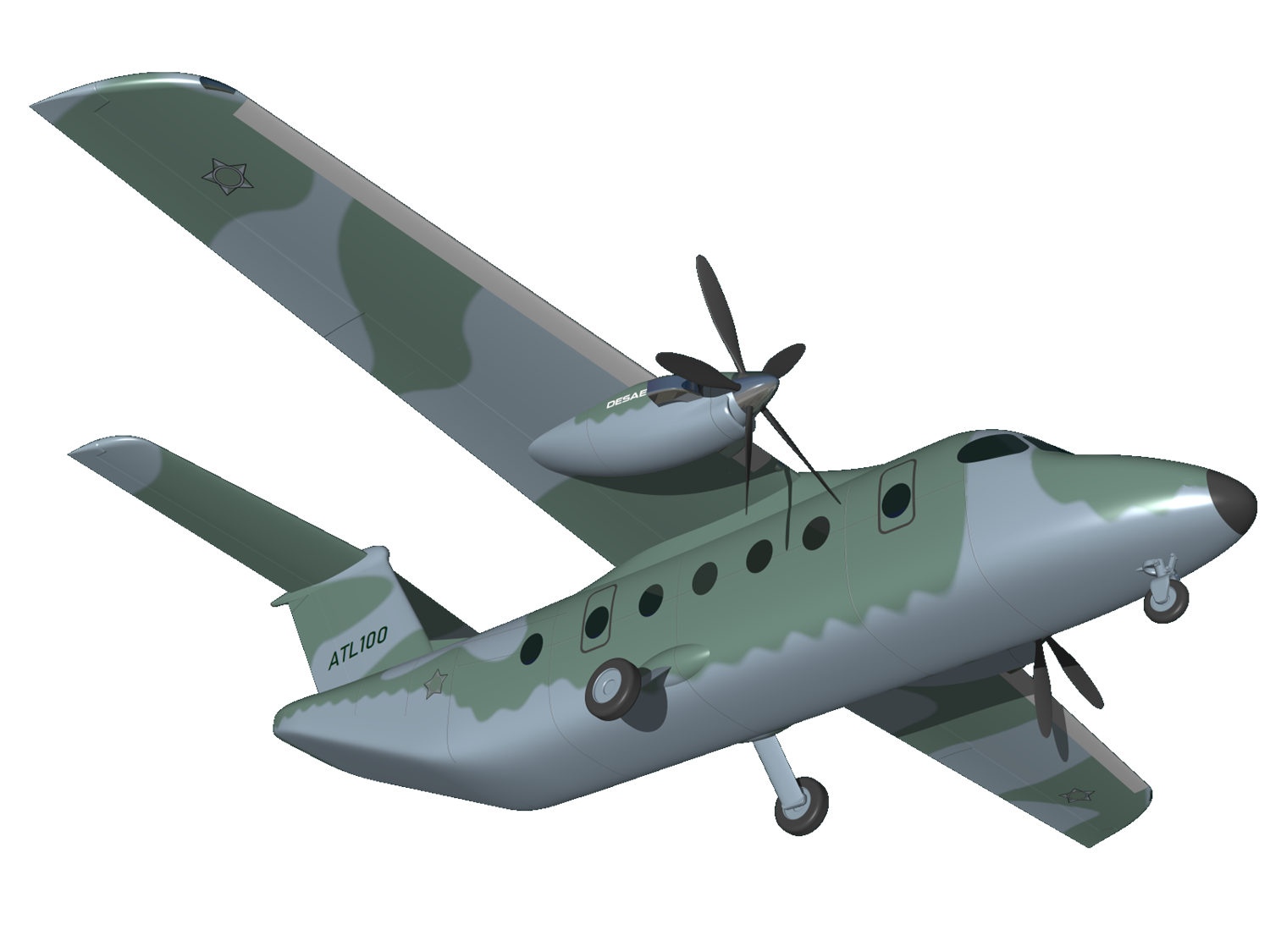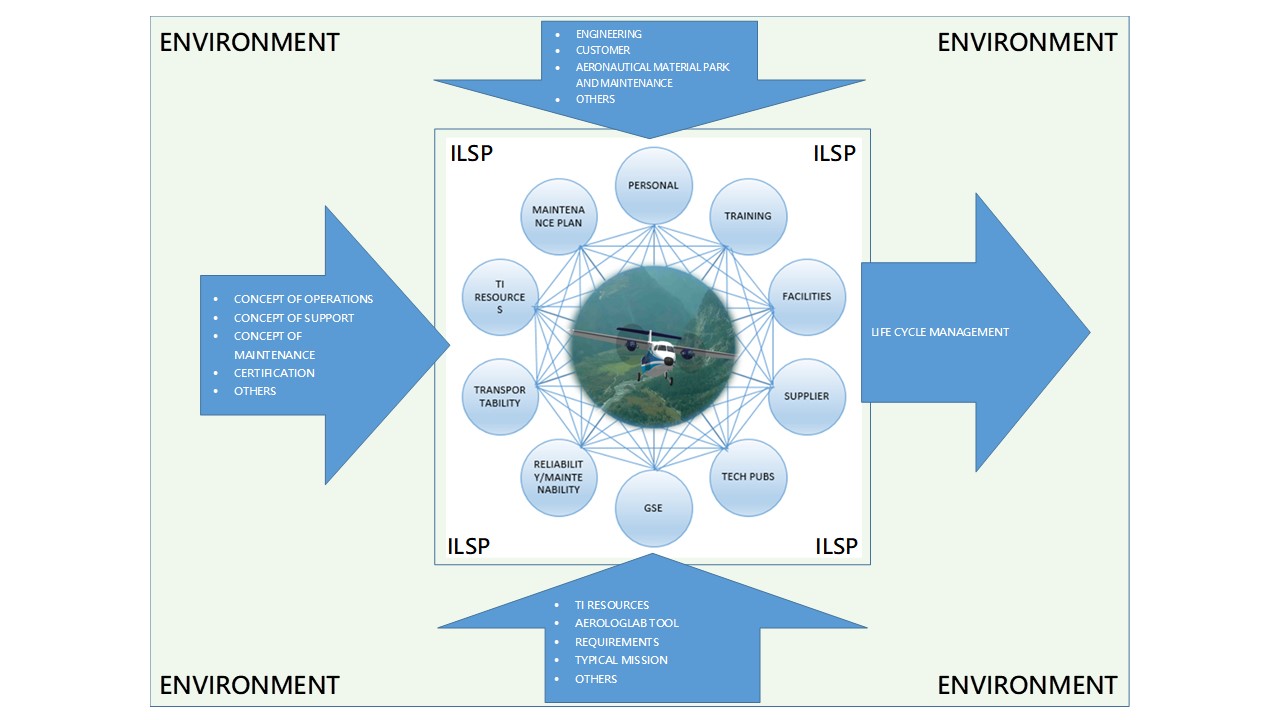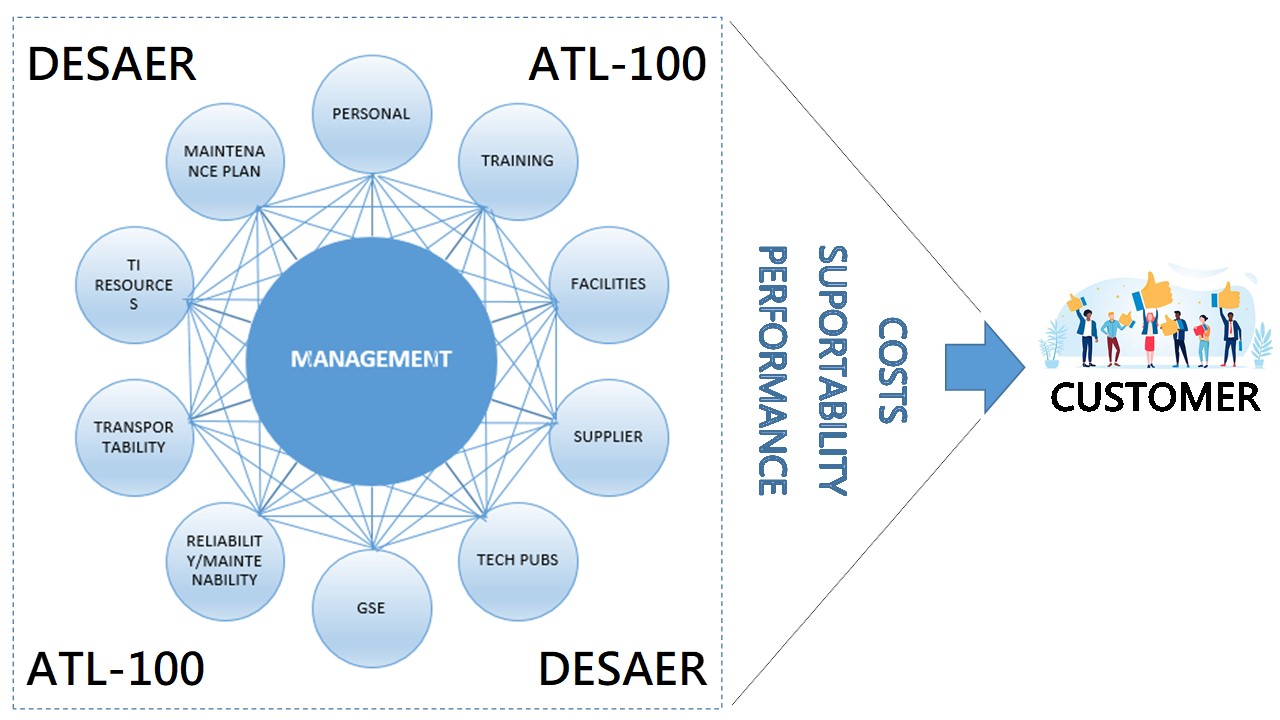System "DESAER ATL-100" approach
for supportability analisys
( something has hindered the system to operate or be supported properly, or objectives are not attained. )
The Brazilian Air Force has been operating obsolete aircrafts in extreme conditions, low performance, limited operative and financial resources, all with an ever growing demand for transportations, most of them in harsh environments.
( sumarize how the system is supposed to operate and be supported to achieve the desired objectives or end state )
The presence of the military in the most diverse regions of the country, including in the borders, is essential for the maintenance of Brazilian sovereignty. In many of these locations, the difficulty of access makes the maintenance of the State`s presence dependent on missions carried out with the use of military aircraft compatible with the airfields landings and takeoffs available in the locations.
In this context, the Brazilian Amazon stands out, a region of approximately 5.5 million square kilometers (km2), with low demographic density, where the means of transport are predominantly fluvial and aerial.
For these reasons, is essential the support with FAB aircraft in the Amazon Region in order to enable the presence of numerous government agencies as the Ministry of Health, the Ministry of Justice and the National Indian Foundation - FUNAI, among others, to enable integration between the capitals and the several municipalities in the interior of the States and to guarantee support to the countless Military Organizations of the Navy, Army and Air Force, mainly in remote regions.
The Amazon Region has paved airports, but the aerodromes that serve small municipalities and the Brazilian Army`s Frontier Platoons, for the most part, have small, unpaved runways (earth, gravel and grass), in addition to being in restricted areas, with trees and other obstacles close to the sides.
To operate in medium and large airports, COMAER currently uses the C-130 (Hercules), C-105 (Amazonas) and C-97 (Brasília) aircraft and, to operate in locations that have short runways (between 800 and 1,200m), the C-95 (Bandeirante) and C-98 (Caravan) aircraft are used. In the case of the C-98 aircraft, which operates on unpaved runways, COMAER`s capacity is very limited due to the small number of these aircraft, in addition to the reduced cargo and passenger capacity.
Due to the characteristics of the Amazon Region, serious challenges are imposed to the military` capacity for strategic mobilization. Although currently mitigated by the use of existing aircraft, the difficulties imposed on the displacement of personnel and material to some locations, in situations that require the use of aircraft from more remote runways, can degrade the performance of military forces and hinder the projection of power aerospace throughout the entire national territory.
The concept of operations this project is based on the needs of the FAB, i.e., of a new fleet of light military transport aircraft, intended for use throughout the national territory. with an emphasis on the Amazon region.
The initial concept for the acquisition and operation of this new aircraft follows below:
a) The design should be of a multi-engine aircraft;
b) With retractable tricycle landing gear;
c) With rear door that allows loading in the longitudinal direction of the aircraft;
d) With high wing;
e) In order to be able to be operated by only a single pilot; and
f) Its employment in the Specialization Program and in the Operational Elevation Program for Aviation Officers must be feasible, carrying out the training and operational maintenance of COMAER crew members in:
- Airborne Assault Actions,
- Air Exfiltration,
- Air Infiltration, and
- TAL, according to the standards established by COMPREP (NOPREP TTP 14 and 18, INPREP PESOP 05).
g) Must be operative on unpaved and short runaways, where ground transportation infrastructure is inadequate or does not exist, robust and easy of maintaining, pax or cargo transport, aft cargo ramp, quick-change for ambulance, humanitarian evacuation, fully equipped paratroopers, troops, and operates in a range greater than 1600 km.

( something that may solve the problem, confront the problem with its application conception. )
The ATL-100 aircraft is the solution for needs of the custome. This system is a new concept of aircraft which will attend fully CONOP of FAB, with regard to good performance, high range, proper load capacity, in a low operational cost and easy maintenance
( something to attend client needs )
An aircraft whole developed for it life cycle, an essential subsidy mainly to deployment phase which is carried out by the customer jointly with the manufacturer. The enter into-service is a moment of great exposition, when from all aircraft are expected: safety, reliabilibility and availablity, i.e., readness, in case of military aircraft. Nowadays, safety, good performance and proper functioning are essential characteristics for a product and the image of the company that created it.
Right after the start of the operation all atentions turns to compliance of Aircraft Maintenance Program, when are evaluated questions like: removal and installation easies, downtimes, parts available and maintenance costs. These factors are else an important output.
The complex systems developments for the life cycle are very important and necessary, because they will comply all planning established relate to costs, times and quality of deliveried product, especially when it comes to a government customer, which depends on annual budget to maintain itself.
( indicators and what must be registered )
1 - Understand all the customer needs presented in the respective documents of request for information and request for proposal.
2 - Based on MIL standards and the International Specification for Integrated Product Support - SX000i.
3 - Know the product (s) that the new aircraft will replace.
4 - Know the competing products.
5 - Establish how and what the goals should be achieved, with the customer.
6 - Define with the customer a base of technical, logistical and industrial requirements - RTLI.
7 - Develop the complex system for the life cycle, mainly considering the RAMS factors, i.e., Reliability, Availability, Maintenability and Safety, and take into account the goals of operating costs, deadlines, in general (especially the response times to queries and aircraft downtimes), and quality in all aspects: be in all and any deliveries, as in the services provided.
( something may not be attended, there are some limitations, what the does not apply, and the environment influence. )
Although there is currently a lot of talk about the use of electrical engine as a sustainable solution for the environment, which without any doubt it is a clean energy form, free of emissions, this technology still ís research object and development around the world, i.e. is not yet certified technology. There are still some limitations for use of this kind of motorization in certains aeronautical projects, mainly regarding the use of batteries (energy sources for the engines). The reliable solution available, which will configure aircraft developments still for some time is the combustion engine.
Thus, the system will not deliver an electric or hybrid engine as a solution for the motorization of the aircraft.
( data, information or material )
1 - The typical mission with the purpose and need to development.
2 - Number of aircraft intended.
3 - Definition of how many and what will be the operationals bases.
4 - Definition of the aeronautical maintenance park.
5 - Gathering market information and and competing products.
6 - Customers experience.

( decompose the system, and tell about its parts relationships. )
Concerning to the physical presence of an Air Force in the main locations of a country is considered relevant subject the responsiveness capacity and operational readiness to the any threat to sovereignty, heritage and territorial integrity. The aim of an Air Force is ensure operational effectiveness, keeping its pace, duration and intensity, considering the logistical and personnel activities involved in the mission.
The capacity for emergency responsiveness and operational readiness is directly related to operational and logistical reliability, as well as maintainability and availability.
The ATL-100 will be developed for high capacity for responsiveness and operational readiness, developed to withstand the severities of military employment.
( confront the environment, supportability issues, and the application conception, information available, research needs, and any known constraint. )
The military transport aircraft is defined in terms of its ability to reach in tactical or strategic air transport, reflecting the needs of the ground forces, who it assists.
The ATL-100 will be a military cargo and troop transport aircraft that:
1 - It will operate in extreme, amphibious and terrestrial conditions, i.e., in ice conditions, desert environments, jungles and coastal regions.
2 - The aircraft will be able to overcome obstacles of up to 60 m in height, i.e., take off and pose, in operations on short unprepared runways.
3 - It will be provided with a hoist, which should run on rails on the aircraft`s roof, mainly comprising the rear, ramp region, and will be able to assist in the lifting and gauging of the weight of the loads to be aboarded.
4 - The aircraft floor and the ramp door will be equipped with rollers that will assist in the displacement of loads.
5 - The aircraft will be provided with a bad weather window that will allow visual access and free communication with the external environment, facilitating maneuvering beacons. This access will favor air circulation in the cockpit.
6 - The aircraft will be provided with an auxiliary fire-fighting system with easy access and removal, available in the cargo compartment.
7 - The wing tip lights lenses will be designed for easy removal and installation, and simple polishing.
8 - The tires will be specified to a higher durability standard, given the high wear history of tire batches operating at the customer.
9 - The windshield system will be entirely made of glass with an intelligent digital temperature sensor to control various temperature ranges in the transparency in order to avoid overheat failures.
10 - The protection system against frost formation at the leading edges of the wing (and horizontal and vertical stabilizer as well) will be of the Pneumatica De-Ice Boots type.
11 - In landing gear system there will be a pressure gauge to facilitate inspection/servicing of aircraft.
12 - The critical systems of aircraft will be equipped with sensors for health monitoring.
13 - In windshield system we will be not used of windshield wipers. Windshield rain repellent coating will be used as a good solution, reducing weight and drag.
14 - The fairing metallization system will not use metal plates as a solution (bronze, copper, aluminum, etc.). It is known that this type of solution, very traditional in aviation, is not robust against corrosion processes. The use of these metal plates hinders the maintenance process for their replacement, in addition to promoting excessive weight. The corrosion process generates expansion of the meshes promoting delamination in the paintwork of the fairing. In all fairings should be used as solution pre-preg mesh with carbon plates. The fairings must be made of carbon fiber.
15 - HF antenna should not be faired on the dorsal fin of the vertical stabilizer, or on itself. The experience on several aircraft with this antenna in this position showed us that with the various maintenance actions throughout the life cycle, the removal and installation of the fairings for inspections ended up damaging the metallization, leading to the degradation of the signal, generating failures on communication system.
16 - Due to the severe landing conditions presented in the requirements (dirt runways, narrow, unprepared, full of gravel) the aircraft will not be equipped with retractable landing gear. The fixed landing gear will offer better operating responses throughout the life cycle.
17 - The aircraft`s flight control system will not be actuated hydraulically, but manually, although the brake system will be actuated by hydraulic control. The goal is to have a "lighter" aircraft, with the least amount of hydraulic lines possible.
18 - The aircraft will be provided with a basic automatic flight control system, and the avionics navigation system will be provided with modern basic systems, for current standard operation with a single pilot.

( how the supportability might be managed. )
The structure of management aims to ensure that the aircraft design development meets the requirements for operational efficiency and that it is also ensured the correct supportability during the life cycle.
DESAER will ensure in its logistics management the planning and control of activities, keeping the development execution status updated and responding promptly to the management needs of the ATL-100 program.
During product development, the teams from the technologies will attend all the tasks defined for each phase. All these teams will monitor the design progress, with due validations throughout the development, in the meetings of phases changes (PDRs and CDRs).
Through this management, DESAER will meet the requirements, deadlines and costs established.
The responsibility for making the main decisions in Integrated Product Development is assigned to the Core Team. These decisions will be supported by specific processes and procedures, i.e.:
- Communication,
- Contract and Acquisitions,
- Costs management,
- Scope Management,
- Resource management,
- Requirements management,
- Risk and Opportunity Management,
- Goals and Investments,
- Integrated planning,
- PDRs and CDRs.
The DIP will be divided by the following processes:
1- Preliminary design phase:
- Establish the best commitment to accomplish the Customer`s needs, according to theirs requirements, those of the Product itself, and those of the Market.
- Define a preliminary configuration proposal with technical and economic feasibility analysis based on the concepts and technologies of structures and systems, definition of lofting and pre-dimensioning of the critical items of structures and systems.
2- Product and Service Detail Phase:
- Understand the complete documented details of all project objects, necessary to allow the product to be identified, manufactured, inspected and used;
3- Development of Productive Processes:
- Create all sequences of operations that will allow the manufacture, inspection, assembly, testing, treatment, painting and finishing or receipt of an item, as well as the development of tooling;
4- Supplier Development:
- Select and contract suppliers, with a view to development and operation;
5- Product Testing and Certification:
- Proceed with the experimental verification and validation of Technical Publications and Product Certification and
6- Support and maintain the product:
- Manage the serial product, with ways to maintain competitiveness.
The responsible for the ATL-100 Program Logistic Support Management will be the point of contact for the customer logistics manager and will be the support in matters related to logistical support throughout the development. The Integrated Logistic Support Team will be a member of the Core Team, will participate in the main project decisions, and will also be responsible for coordinating the exchange of logistical information and actions resulting from the logistics meetings.

( Academia vs Industry possibilities )
The ATL-100 aircraft will be a modern project developed for the most modern maintenance concepts, with low logistical cost per flight hour, shorter repair time and low operating costs, with significative cargo and personnel transport capacity to isolated places, and high DISPATCHABILITY rate, which positions it as a good compromise solution, in a cost-benefit ratio, in the missions of integration of the national territory carried out by the wings of the FAB, especially in the less populated areas of the Amazon Region.
- The ATL-100 design will provide agility in loading and unloading material through the rear ramp door (longitudinal entry and exit to the cargo cabin).
- The modifications from internal cargo configuration to pax or to MedEvac will be to carry out quickly;
- The ATL-100 project will offer greater safety in flight as it is a multi-engine aircraft. The aircraft will be composed by a modern structural design and state-of-the-art navigation instruments provided as well. The aircraft also will be able to operate on small, unpaved runways of small dimensions, where only small aircraft operate.
- The ATL-100 will be able to land on a highway to be refueled hot, for immediate return to the mission.
- The aircraft is being designed to be operated by a single pilot.
( something about the first deploy, supportability issues, and need for anything related to the 12 IPS elements. )
01 (one) year before the enter into-service of the first aircraft, according to the contract stablished, will be delivered to the customer:
- 01 (one) IPL (Initial Provisioning List) with the minimum number of parts considered most critical for the due to provisioning to start the operation.
- 18 (eighteen) months before the start of the operation, the Technical and Operational Publications will be delivered for knowledge and respective personnel training.
- According to training schedule,18 (eighteen) months before the start of the operation, training for workshop personnel will begin.
- The amount of labor per specialty will be informed 02 (two) years before the first aircraft enters service.
- The final ILSP will be delivered 06 (six) months before the start of the operation. for preparing and scheduling Air Force activities.
- 01 (one) year before the start of the operation, all GSEs (Ground Support Equipments) will be delivered to the customer.
( position in systems list )

